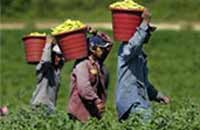US government to regulate payments to foreign farm workers
New governmental regulations introduced in the USA stipulate smaller payments to foreign farm workers who come to the United States. The government made the decision in an attempt to make US-based companies stop hiring illegal immigrants.

The current pay for H2-A visa holders (agricultural workers) varies from state to state. The payment is set by the Agriculture Department's Farm Labor Survey. Within a state the pay remains unchanged regardless of workers’ jobs.
However, the Labor Department would like to introduce a special regulation to specify and distinguish workers’ jobs and skills. It would give an opportunity to pay wages that would be considered appropriate to each territory.
The H-2A temporary agricultural program establishes a means for agricultural employers who anticipate a shortage of domestic workers to bring nonimmigrant foreign workers to the U.S. to perform agricultural labor or services of a temporary or seasonal nature. Before the U.S. Citizenship and Immigration Services (USCIS) can approve an employer's petition for such workers, the employer must file an application with the Department stating that there are not sufficient workers who are able, willing, qualified, and available, and that the employment of aliens will not adversely affect the wages and working conditions of similarly employed U.S. workers. The statute and Departmental regulations provide for numerous worker protections and employer requirements with respect to wages and working conditions that do not apply to nonagricultural programs. The Department's Wage and Hour Division, Employment Standards Administration (ESA) has responsibility for enforcing provisions of worker contracts.
"Temporary or seasonal nature" means employment performed at certain seasons of the year, usually in relation to the production and/or harvesting of a crop, or for a limited time period of less than one year when an employer can show that the need for the foreign workers(s) is truly temporary.
The wage or rate of pay must be the same for U.S. workers and H-2A workers. The hourly rate must also be at least as high as the applicable Adverse Effect Wage Rate (AEWR), federal or state minimum wage, or the applicable prevailing hourly wage rate, whichever is higher. The AEWR is established every year by the Department of Labor for every state except Alaska. Employers should consult with the SWA or the Department of Labor National Processing Center to determine what the rate is for their state.
If a worker will be paid on a piece rate basis, the worker must be paid the prevailing piece as determined by the SWA. If the piece rate does not result in average hourly piece rate earnings during the pay period at least equal to the amount the worker would have earned had the worker been paid at the hourly rate, then the worker’s pay must be supplemented to the equivalent hourly level. The piece rate offered must be no less than what is prevailing in the area for the same crop and/or activity.
Subscribe to Pravda.Ru Telegram channel, Facebook, RSS!


